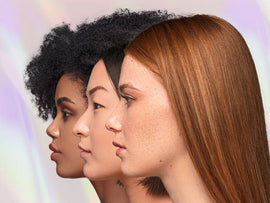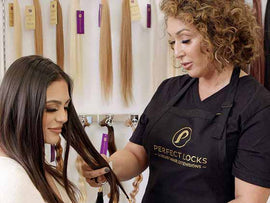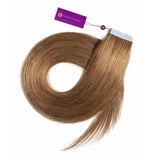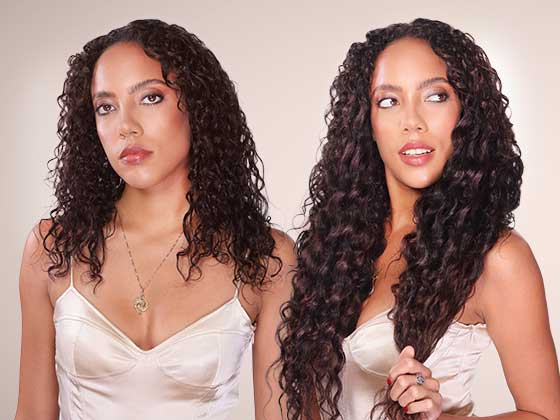Is it time for a new hair color? Your best option is to visit your favorite salon and get a professional hair color. Attempting to do it yourself can lead to hair issues if you are unfamiliar with the technique. In addition, the dye you buy may not give the outcome you want or be different from your expectation.

It is where the hair color wheel comes in handy. Professional stylists use this tool when suggesting the most flattering color to suit the skin tone of their clients. Understanding how it works will help you find the colors that complement your crowning glory.
What is the hair color wheel?
A hair color wheel is a spinner with twelve colors. The colors are grouped into primary, secondary, and tertiary. Red, yellow, and blue are the primary colors. They are the base colors and are used to produce secondary or tertiary colors.
The secondary colors are green, violet, and orange. When you mix blue and yellow, you get green. Orange is the outcome of the red and yellow mixture, while violet comes from the blue and red.

Mixing equal parts of one primary and one secondary color produces tertiary colors. The tertiary colors are red/orange, orange/yellow, green/blue (turquoise or teal), yellow/green, blue/violet (indigo), and violet/green (maroon).
There are color wheels with numbers to describe or indicate the hair color tone, making the shade combination easier. Other color wheels have undertones and hair levels. You need to use these elements accordingly to help you tone, neutralize, or enhance your hair color.
How does a color wheel work for hair?
Stylists rely on the hair color wheel when formulating a specific shade or tone for their clients. They mix multiple tubes of dyes in certain ratios to produce the perfect tone that will enhance the current state of the hair. Rather than using one color tube, professional hairdressers formulate a specific color to enhance, cancel, or neutralize the unwanted or faded tones in the hair.

If your hair color is faded and has a reddish hint, you need to neutralize your hair before you can achieve your dream color. For example, you want a natural brown color. Rather than using a brown dye, you can cancel out red with green, the opposite color on the wheel. The amount of neutralizing color depends on the amount of red in your hair.
The color wheel tells you how to achieve the right tone for your hair condition. Remember that when you lighten the color, it pulls warm. Expect your hair to turn orange, red, or yellowish. Toning is the key to removing the unwanted brassy or golden blonde tint. However, if you want to enhance and brighten the blonde, you can neutralize it with a violet base. Avoid using bleach to lighten the yellow color.
The hair color theory
The science of how colors work is called color theory. It is a crucial aspect of hair coloring, revealing how different colors interact with each other to produce specific effects. With the help of a color wheel, you can determine the colors that complement each other. It helps stylists choose dyes to mix and achieve a desired shade. To better comprehend the hair color theory, it is vital to understand the following:
Hue
Hue refers to a particular color variant or family of colors. Every existing hue is the result of combining primary colors in varying proportions. Mixing equal amounts of red, blue, and yellow produces natural-looking colors from dark to light.
The position of colors on the hair color wheel indicates the tone. Tonal colors can be natural or artificial and are classified into cool, warm, or neutral. On the left side of the wheel are the cool tones (also called ash tones), which include blue, blue-violet, green, blue-green, violet, and red-violet. The warm tones, which consist of red, red-orange, yellow, yellow-green, orange, and yellow-orange, are on the right side of the color wheel. Neutral tones have balanced cool and warm pigments.
Level
The darkness or lightness of color is called level or depth. It is the result of mixing two or more colors. The darkest among primary colors is blue, while the lightest is yellow. Levels 1 to 2 are black shades, 3 to 7 are brown shades, and 8 to 10 are blond shades.
The ten levels of hairdressing are:
- Level 1 - Darkest Black
- Level 2 - Black
- Level 3 - Darkest Brown
- Level 4 - Dark Brown
- Level 5 - Medium Brown
- Level 6 - Medium Light Brown
- Level 7 - Lightest Brown
- Level 8 - Dark Blonde
- Level 9 - Medium Blonde
- Level 10 - Lightest Blonde

Intensity
Intensity indicates the hair’s strength or saturation. Natural hair gets its color from the melanin pigments (eumelanin and pheomelanin). Eumelanin produces black and brown pigments, while pheomelanin produces red and yellow pigments. Red hair has a lot of pheomelanin, brown or black hair has a large quantity of melanin, light blonde contains little melanin and more keratin, and white hair has little or no pigment.
The color is in its “pure form” if it is at a darker and more saturated level. On a scale of 10, the highest level of intensity is deeper, saturated color. The medium level is intense, while the lowest level is subtle and muted.
Complementary colors
Complementary colors are the colors that sit across the wheel. They are blue and orange, purple and yellow, or red and green. When you mix two complementary colors, the result is gray or brown.
Putting a pair of complementary colors next to each other creates contrast because they pop. For example, if you like highlighting your eyes, pick a shade that flatters them. In addition, mixing complementary colors can cancel each other and become a natural or neutral color like gray, brown, or white.
Different hair color chart
A hair color chart is essential when changing or enhancing hair color. It features different shades of main colors in warm, cool, and neutral tones. The common shades based on natural hair colors are:
Blonde
- Warm Reds - Ginger, Bright Copper, Strawberry Blonde, Auburn, Warm Cinnamon, Scarlet Red
- Cool Reds - Cherry Cola, Raspberry, Burgundy
- Other shades - Apricot, True Red, Scarlet, Amaretto, Ruby Fusion, Garnet, Plum, Chocolate Cherry, Midnight Ruby, Reddish Brown, Red Hot Cinnamon
Gray
- Cool Gray
- Blue Gray
- Glaucous
- Dark Gray
- Charcoal
- Ash Gray
- Battleship Gray
- Light Gray
- Medium Gray
- Gunmetal Gray
- Pewter
- Slate Gray
- Stone Gray
- Silver
- Storm Cloud
- Platinum
- Sage Green
- Smoke
- Steel Gray
How to use the color wheel for hair dye
When you understand how the color wheel shows the relationship of colors, it will be easy to pick the right color or shade that complements your skin tone.
First, you need to identify your skin undertone by looking at the veins at your wrist. If you have green veins, your skin's undertone is warm. When the veins are purple or blue, you have a cool undertone. If there is a mix of green and blue or colorless, your skin’s undertone is neutral.

Next, understand that warm-skin-toned people may opt for copper, auburn, or golden blonde dyes. Those with cool undertones look best with cool shades like ash blonde or lilac. For neutral skin undertones, any shade will look good on them.
Avoid moving more than two shades darker or lighter each time you dye your hair. If you want ash blonde and you have brown hair, you need multiple sessions. It requires the professional help of a hairdresser to prevent damaging your hair and achieving a perfect result.
How to get your dream color
You can easily get a gorgeous hair color that suits your complexion. Whether you are getting a salon coloring job or a DIY, the right shades and tones help you achieve the hair color of your dream. It is necessary to consider the following:
- the existing color of your hair
- your preferred color
- go lighter or darker
Use the hair color wheel to determine the perfect shades to add to the formula that delivers your expected outcome. You may also consider the underlying pigment and neutralizing tone to get your desired look.
Here’s a quick guide:
- Light pale blonde hair - light pale yellow (underlying pigment) and light pale violet (neutralizing tone)
- Light blonde hair - pale yellow (underlying pigment) and pale violet (neutralizing tone)
- Blonde hair - yellow (underlying pigment) and violet (neutralizing tone)
- Medium blonde hair - yellow-orange (underlying pigment) and blue-violet (neutralizing tone)
- Dark blonde hair - orange (underlying pigment) and blue (neutralizing tone)
- Light brown hair - orange-red (underlying pigment) and blue-green (neutralizing tone)
- Medium brown hair - red-orange (underlying pigment) and green-blue (neutralizing tone)
- Dark brown hair - red (underlying pigment) and green (neutralizing tone)
- Darkest brown hair - dark red (underlying pigment) and dark green (neutralizing tone)
- Black hair - dark red (underlying pigment) and dark green (neutralizing tone)
If you do not want to dye your hair, an excellent option is to wear clip-in extensions that are beautifully colored and blend well with your natural hair. Extensions are a fun and trendy way to showcase your highlights and lowlights without dyeing your hair.
Takeaway
Wear your hair as your crowning glory at all times. Keeping it vibrant, healthy, and beautiful requires care and treatment regularly is a must-do. Enhancing it with color or highlights is one way to add dimension, depth, and glow. To maximize the benefits of dyes, understanding the relationship of colors through the hair color wheel can help you pick the best shade and tone for your tresses.
People also ask
1. Should you go darker or lighter with hair color as you age?
The rule of thumb is to get a shade or two lighter than your natural hair as you age. Take into account that your skin becomes lighter and your features get sharper with age, so avoid too dark colors. Choose the most flattering colors that suit your complexion, and you’ll never go wrong. Lighter colors can make you look youthful, but always consider the tone. For example, if you have warm undertone skin, opt for shades that provide warmth, like a honey blonde with subtle lighter highlights. Avoid cool and ashy tones and too-dark colors.
2. How do I know what hair color is right for me?
Finding the right hair color that suits you depends on your natural hair color and skin undertone. The color should complement your complexion and highlight the color of your eyes. If you have a warm skin tone, consider strawberry blonde, bronde, champagne blonde, ash brown, espresso, chocolate brown, burgundy, intense red, and cherry. Warm colors like honey blonde, golden blonde, caramel, chestnut, light golden brown, mahogany, butterscotch brown, copper, auburn, and ginger if you have a cool skin tone.
3. How to use the color wheel to neutralize color?
Neutralizing a hair color means toning down a bright color or creating a shadow. You can do it by using a small amount of the opposite color on the hair color wheel. When it comes to neutralizing or canceling out colors, there are some key guidelines to keep in mind. Firstly, green is the ideal choice for neutralizing red tones. If you're dealing with orange hues, blue is the color that will effectively cancel them out. When faced with yellow shades, either violet or purple can be used to achieve a neutralizing effect. By understanding these color relationships, you can effectively balance and harmonize different tones in your artistic endeavors or when dealing with color-related challenges.
















